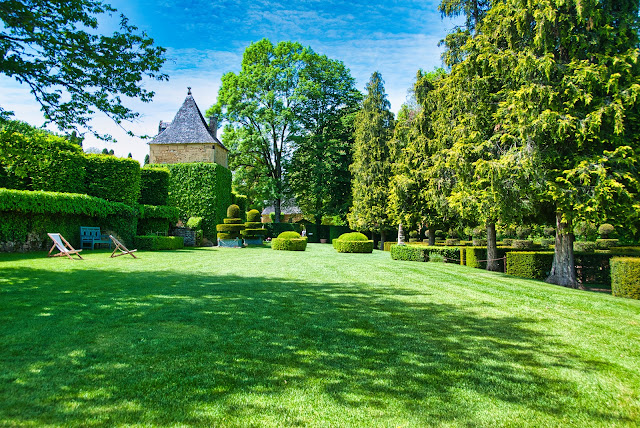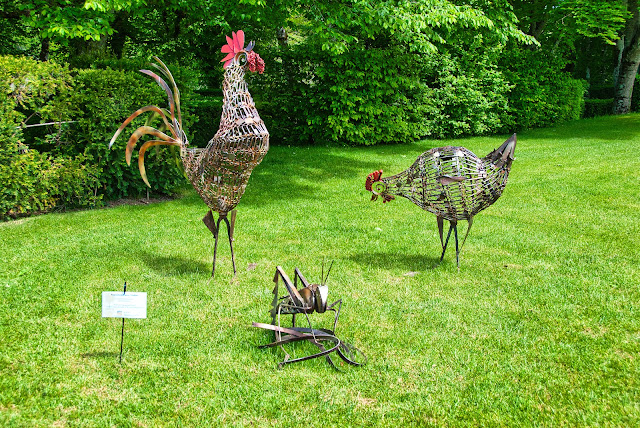First, A Little Background
The Dordogne is both an area and a river. France is highly confusing in that there are regions, departments, communes and several other divisions I forget. So the Dordogne is in the region of Nouvelle Aquitaine, the area Dordogne is a department (#24) and the department is divided into 4 sub departments eventually ending up in communes. However, if that is not complicated enough, people (but not the government) refer to the area as either Dordogne or the Perigord depending on their mood or time of day. Yes, of course, the Perigord is itself divided into four sections (White, Black, Purple and Green) associated with each area's particular virtue. The Black area for its truffles and forests, Purple for its wine, Green for its rolling meadows and White for the chalk and white stone unique to the area. The Dordogne River is one of the prettiest I have ever seen (photos will follow at some point) and runs willy-nilly through all four areas (I'm pretty sure). OK. Enough geography. On to the stuff you actually read our blog for --scenic beauty and our miscalculations and near disasters while traveling.
First the Beauty Part
After settling in, we headed to Eyrignac Gardens. As noted, Dordogne was in full blown spring and I anticipated the gardens being awash with flowering plants of infinite variety. No. Well, some flowers. But, at least in this part of France, gardeners are heavily into topiary. This requires huge amounts of precision clipping for many months of the year. Most choose to do it by hand -- which means a LOT of hands are employed doing this. In the case of these gardens it takes 20,000 hours annually to keep things tidy. After almost two weeks of pretty heavy duty moving around it was a relaxing break to just amble through the gardens with no plan or direction. And then, it was time to get back into the action.
 |
| The view of the gardens from the terrace where we ate lunch. The gardens cover 10 hectares (24 acres). |
 |
| The Alée des Charmes is 100 meters long and consists of hornbeams & yews between the hornbeams. The hornbeams must be pruned by hand every month between May & September. The yews only require pruning twice a year. |
The main detail of the garden is the topiary, but there are also broad lawns.
 |
| This is the terrace where we enjoyed a delicious lunch while looking over the gardens. |
 |
| The Pavilion of Rest, which dates from Louis XV, as seen though the arch of greenery. |
 |
| The large pond was called the "mirror" and was originally used as a fish hatchery. |
 |
| As can be seen from this photo & the following photos, topiary is one of the outstanding features of this garden and not flowers. |
 |
| Another feature of the gardens were the sculptures. If you look closely you will see the sculpture is largely made of old keys. |
 |
| A guest cottage with a slate roof. The slate on the roofs could weigh as much as 700 kilograms per square meter. |
 |
| There were a few flowers in the garden, but they were not as prominent as the sculpted hedges. |
 |
| A view of the Alée des Charmes from the opposite end. |
 |
| Two view of the manor house, which dates from the 17th century... |
 |
| and is known as Artaban Manor. An ancestor wrote a monologue entitled "Fier comme Artaban", which can be translated in English as "Proud as a Peacock". |
 |
| This photo of a photo gives the best perspective view of most of the gardens and a portion of the manor house. |
 |
| More sculptures in the gardens, all made from old keys. |
 |
| A side view of the manor house with Deirdre exiting the pedestrian gate. |
A Case of Obstinate Optimism
We have finally given ourselves a diagnosis for what causes us to repeatedly get ourselves into unfortunate, and occasionally terrifying travel situations. Yes, the ailment is Obstinate Optimism. A condition typified by fastening onto a belief which you or authorities have proposed and, even after sensing that it is sheer lunacy, you are incapable of changing direction because you are sure "it will all work out". Our latest flair up of the condition occurred in Beynac.
Beynac is an amazing castle set high (very, very steeply high) above the Dordogne River. We set out to visit it but had little interest in scaling its heights via several (at least) hundred steps. Reading an article I excitedly told Michael: "Listen to this. If we just go past the last parking lot and follow the signs to the Castle, the road will take us all the way to the top. Hurrah!" So, we did that. And yes, there was a road after the parking lot. And yes, it did have signs to the castle. But it was a little road. (OK, here we start to display the telltale symptoms.) "Well, I don't know. This doesn't look right," one says. "But look, there are cars in garages, it will be be OK."
We reach a crest and can no longer ascend. Rather than turn around or back down, we descend via an even smaller route. Mistake #2. We now encounter a hair pin turn of such an acute angle that nothing but perhaps a Smart Car could negotiate it. "I think we can make it." (Mistake/ Delusion #3). At the hairpin is a stone wall on which are perched many people resting after their arduous climb halfway to the Castle. Michael performs multiple maneuvers to clear the turn with no success. Two young Frenchmen jump from the wall to provide guidance. Each attempt is greeted by groans or sharp intakes of breath by the observers on the wall.
The reverse gear doesn't hold and Michael hits the wall (but not THAT hard). "Sacre Bleu! Mon Dieu! the crowd emotes. At times the car is on three wheels -- once two. Finally, our guides manage to direct Michael to get the car backed up to where we can turn around and retrace our steps up the tiny road to the somewhat less tiny road. The hill is so steep I must exit the car to lighten the load (ahem!). After three attempts, and much burning rubber, Michael gets the car to the crest of the hill. Cheers erupt from the onlookers. I hug our two French saviors (who said the French are difficult?) and then confront and conquer the hill on foot. We decide we will not do Beynac that day. "Well, that wasn't as bad as it could have been," one says. It appears we have not yet dealt with our issue.
The Gardens of Marqueysac
What we needed, we decided, was a low stress, low energy activity to recuperate from our morning trauma so we headed to another amazing garden. However, like virtually every other thing in Dordogne the gardens were set on a significant hill and kept climbing relentlessly. This somewhat diminished their relaxing quality. After ascending the first formidable path to the entry and chateau and having completed a tasty lunch (French food even at tourist sites is pretty terrific - no burgers or dogs here!) we girded ourselves for a lengthy hike uphill to the belvedere.
 |
| A couple of rooms of Marqueysac Manor were available for viewing --- the living room and... |
 |
| the dining room. |
 |
| This details the creation of the Michelin Man by a former resident of the Manor who initiated "the first ever international mass distribution advertising campaign". |
 |
| Examples of early posters used in advertising featuring the Michelin Man. |
Michael led the way and, after a short distance, he turned to me and said: Oh-h-h...Deirdre, you are NOT going to like this..." I stepped back and said, "It's a snake isn't it. I know it's a snake (phobia #2). Is it an Asp?" The snake (4 and 1/2 slithery feet long) was doing its best to get away but there was dense topiary on both sides sitting above a 3" high edging of granite which he/she couldn't negotiate very well. Finally, the serpent found an opening and left us.
 |
| The snake. |
While somewhat agitated and fearful I was not actually terrified because I had (as always) fully researched all venomous and/or disgusting creatures we might encounter in the locale we were visiting. The only venomous snake was the Asp which is short (like a foot and a half) but a little aggressive. They are fairly prevalent in Europe and, in some rural areas, locals are known to keep anti-venom in their fridges. But enough of that. After coping with my second upset of the day we continued on and finally reached the Belvedere and an astounding view over the countryside and the Dordogne River. Enough for one day.
 |
| A view of the rear of the Manor house as we begin our ascent through the garden. |
 |
| As we ascended the view of the towns... |
 |
| and the countryside became more spectacular. |
 |
| This is a view of Beynac Castle from Marqueysac Garden. |
 |
| This cloche cabane in the garden was created by piling stones up without using any mortar. |
 |
| A view of the interior dome. The word cloche in French translates to bell in English. |
 |
| This lone tree perched on the edge of the cliff stood out as we continued our ascent. |
 |
| We were still not to the highest belvedere yet as this photo shows people above us. |
 |
The view of the town and the countryside...
 | as well as the gabarres (tourist boats) became even smaller as we finally reached the highest belvedere.
The gabarres are flat bottomed and were originally designed to transport goods along the shallow Dordogne River.
As we finally made our descent from the heights of the Marqueysac garden we spotted this peacock pair shown below.

So, that's it for this post. Next up: A Renewed Assault on Beynac Castle and a marvelous Chateau with a marvelous story. Have fun and stay cool our friends North of the Border. |
|




































Thanks, Deirdre and Michael. You always find such lovely places to visit and your adventures make very interesting stories . Lloyd
ReplyDeleteYou both love your adventures, admit it. Wonderful tale. Mary
ReplyDelete